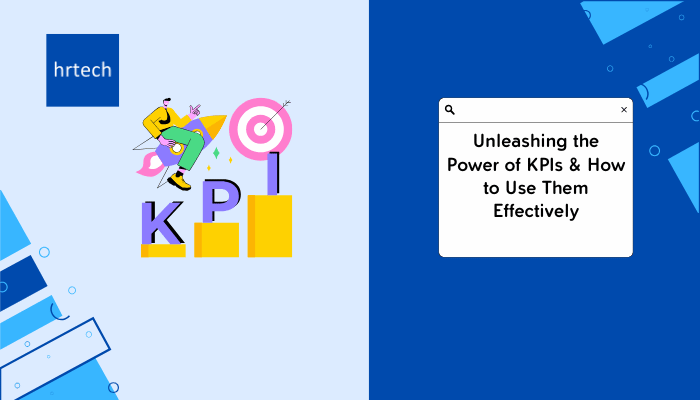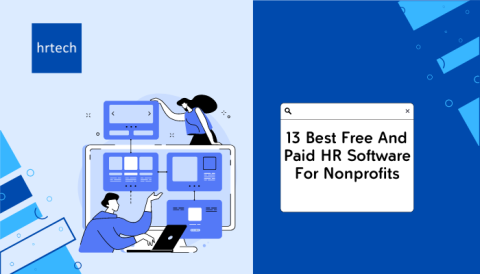Have you ever thought of having a crystal ball that reveals exactly how your employees are performing? Wouldn’t that be incredible? Well, guess what?
You don’t need magic – you just need KPIs!
KPIs are essential tools for HR professionals and managers across all organizational levels to measure, manage, and enhance performance. They provide a data-driven way to measure employee performance, identify areas for improvement, and ultimately, unlock your team’s true potential. But with so many metrics out there, choosing the right ones can feel overwhelming.
But fear not! This article is your one-stop shop for mastering the art of employee KPIs. We’ll delve into the importance of KPIs, explore powerful examples across different roles, and equip you with the knowledge to implement them effectively.
Why Do KPIs Matter (More Than You Think)?
Think of your organization as a high-performance race car. To win, you need to track its speed, fuel efficiency, and overall performance. Similarly, KPIs act as the dashboard for your workforce. They provide crucial insights into individual and team effectiveness, allowing you to:
Identify Strengths and Weaknesses: KPIs pinpoint areas where employees excel and areas that require additional support.
Set Clear Goals: Specific, measurable KPIs translate objectives into actionable steps, keeping everyone aligned.
Measure Progress: Track performance over time and gauge the effectiveness of training programs or new initiatives.
Make Data-Driven Decisions: KPIs provide a solid foundation for informed decisions about talent development and resource allocation.
They help you understand what people excel at and where they might need support.
Think of it like a fitness tracker for work – employees gain a clearer picture of their progress and stay motivated by reaching goals, while organizations can identify areas for improvement and track the impact of training programs.
KPIs are like a win-win – they foster accountability, boost productivity, and ultimately lead to a stronger bottom line.
Now, let’s dive into some real-world examples. Sales teams might track deals closed or customer satisfaction, while marketing focuses on website traffic or conversion rates.
But these are just a starting point! The key is to pick KPIs that fit your specific roles and company goals. Of course, measuring the impact of initiatives can be tricky.
Defining KPIs and Their Benefits:

Ever feel like you’re flying blind when it comes to measuring your team’s performance? KPIs are here to be your guiding light! Let’s break it down:
What are KPIs?
KPIs, or Key Performance Indicators, are quantifiable measurements that track progress towards your business goals. Think of them as a dashboard for your organization, giving you a clear picture of how well things are going.
They’re crucial because they help you identify strengths, weaknesses, and areas for improvement, ultimately leading to a more successful and productive team.
Not quite! Metrics are any measurable data point, like the number of website visitors. KPIs, on the other hand, are a specific subset of metrics that are directly tied to your strategic objectives.
For example, website traffic might be a metric, but your KPI could be the conversion rate of those visitors into paying customers.
Setting clear goals is the roadmap for your business. It gives everyone a sense of direction and motivates them to strive for success. And KPIs? They’re the measuring sticks that show you how close you are to reaching those goals.
How Do KPIs Evaluate Organizational Performance?
KPIs act as a window into your organization’s overall health. By tracking key metrics in different areas like sales, marketing, and HR, you can identify trends, measure the effectiveness of initiatives, and make data-driven decisions to optimize performance across the board.
Types and Examples of Employee KPIs:
These KPIs are all about aligning individual performance with your organization’s long-term goals. Think of them as the compass guiding your team.
Example: Sales reps might have a strategic KPI of increasing market share by a specific percentage.
Comparison of Employee Performance KPIs:
Short-Term Wins: Operational KPIs:
Imagine you’re running a race. Operational KPIs are like the markers you see along the track, telling you how you’re doing in the short term. While they focus on short-term performance and day-to-day operations, they should also be aligned with the organization’s long-term goals and strategies to ensure cohesive progress.
Example: A customer service team might track their average call handling time. This KPI helps them understand how long it typically takes to resolve customer issues. If the average time is high, the team can investigate what’s causing the delays and implement solutions to bring it down, leading to faster customer service.
Looking Forward vs. Looking Back: Leading vs. Lagging KPIs
Think of KPIs as a time machine. Leading KPIs are like looking into the future, while lagging KPIs are like looking back in time.
Leading KPIs: These KPIs predict how your team might perform in the future based on their current actions. An example could be the number of training courses completed. If a team completes a lot of training related to a specific skill, this leading KPI suggests they might be more efficient or knowledgeable in that area in the future (lagging KPI).
Lagging KPIs: These KPIs measure the results of past actions. They tell you how well your team performed in a specific period. Let’s say the lagging KPI, employee skills, is measured after the training. A high score in this lagging KPI would support the effectiveness of the training indicated by the leading KPI (training completion).
Beyond the Numbers: Soft Skill KPIs
KPIs aren’t just about hard data like numbers of reports or sales figures. They can also measure the “softer” skills that contribute to success, like employee satisfaction and teamwork. Here are some examples:
Productivity: This measures how much work gets done in a specific time. It could be the number of reports generated per hour or the number of customers served by a salesperson.
Satisfaction Index: This gauges how happy and content employees are with their work. It’s often measured through surveys. A high satisfaction index can indicate a more engaged and motivated workforce.
Efficiency: This measures how well resources (like time and money) are used to achieve a goal. For example, a team might track their project completion rate within deadlines to assess efficiency.
Engagement: This measures how invested employees are in their work and the organization. Engaged employees are more likely to go the extra mile and contribute their best effort.
Whole Package- Performance and Development KPIs:
A well-rounded set of KPIs should consider both an employee’s current performance and their potential for growth. Here are some examples:
Performance Ratings: These are formal evaluations of an employee’s overall effectiveness, often conducted through standardized performance reviews.
Goal Achievement: This tracks how well employees are progressing towards their individual and team goals. Clear and measurable goals help keep everyone focused and motivated.
Skills Development: This measures an employee’s participation in training programs and skill development initiatives. Investing in employee skills can lead to a more capable and adaptable workforce.
Collaboration and Innovation:
Success often hinges on teamwork and creative thinking. Here are some KPIs that focus on these areas:
Collaboration: This measures how well different departments or teams communicate and work together on projects. This could be tracked by monitoring cross-departmental communication or project team success rates.
Innovation: This measures the number of new ideas submitted or implemented by employees. Encouraging innovation can lead to new products, services, or ways of working that give your organization a competitive edge.
Customer Service Feedback: This tracks customer satisfaction scores that reflect how well employees interact with customers. Positive feedback indicates a team is delivering excellent customer service.
Setting the Right KPIs- Choosing the Metrics that Matter:

Now that you’ve seen the different types of employee KPIs, let’s dive into how to pick the perfect ones for your organization. It’s not about tracking every single metric – it’s about choosing the most impactful ones that align with your goals. Here are some key steps:
Targeting the Bullseye- Selecting Effective KPIs:
Don’t get lost in a sea of data! Here’s how to select effective KPIs:
1. Identifying Critical Success Factors (CSFs): The Foundation of Your KPIs:
Think of CSFs as the pillars holding up your business. They are the absolute must-haves for your company’s success. Imagine you’re a recruiting firm. Your ultimate goal is to place top talent with your clients, so attracting those highly skilled candidates becomes a critical success factor (CSF). Here’s how CSFs work:
Identifying your CSFs: Take some time to brainstorm and define what absolute necessities drive your business forward. What are the non-negotiables that guarantee your success?
Building your KPIs on CSFs: Once you have your CSFs, use them as the foundation for your KPIs. The KPIs you choose should directly measure progress towards achieving these critical success factors.
Example: Let’s say another CSF for your recruiting firm is building strong relationships with potential clients. A KPI based on this CSF could be the “number of new client meetings scheduled per month.”
2. Applying the SMART Criteria: Creating Clear and Actionable KPIs:
Imagine a blurry picture – that’s what un-SMART KPIs are like. The SMART criteria ensures your KPIs are clear, focused, and actionable:
Specific: Exactly what are you measuring? Don’t use vague terms like “improve.”
Measurable: Can you quantify the KPI with a number or a specific outcome?
Attainable: Is the KPI achievable with realistic effort and resources?
Relevant: Does the KPI directly relate to your goals and CSFs?
Time-bound: Is there a specific timeframe for achieving the KPI?
Example:
Un-SMART KPI: “Improve recruitment effectiveness” (vague, not measurable)
SMART KPI: “Reduce time-to-hire for software developer positions by 10% within the next quarter” (specific, measurable, attainable, relevant, time-bound)
3. Aligning KPIs with Goals and Strategic Objectives: Ensuring Measurement Matters
Your KPIs shouldn’t exist in a vacuum. They should be directly tied to your overall goals and strategic objectives. Think of it like a roadmap – your goals are the destination, and your KPIs are the milestones along the way:
Understanding your goals: What are you ultimately trying to achieve as a business? What are your strategic objectives (long-term plans) for reaching those goals?
Connecting KPIs to goals: Choose KPIs that directly measure progress towards your goals and objectives.
Example: Let’s say your strategic objective is to increase revenue by 20%. A relevant KPI sample for this could be the “number of new clients acquired per quarter.” As you acquire more clients, your revenue is likely to increase, helping you achieve your strategic objective.
By following these steps, you’ll choose KPIs that provide valuable insights and guide your team towards achieving your strategic goals.
Specific Examples of Employee Performance KPIs:
So, you’ve grasped the importance of KPIs and how to set them effectively. Now let’s get real! Here are some specific examples of KPIs across various departments to inspire you:
Financial KPIs- Numbers that tell the money story:
Gross Profit Margin: Measures profitability after accounting for the cost of goods sold. Sales reps might have a target KPI for upselling products to increase gross margin.
Net Profit Margin: The ultimate profitability metric, reflecting profit after all expenses. A KPI for a cost-reduction initiative could be a targeted improvement in net profit margin.
Inventory Turnover: Tracks how efficiently inventory is managed. A KPI for a warehouse team could be reducing inventory turnover by optimizing storage and picking processes.
Marketing & Sales KPIs- Generating leads and driving revenue:
Lead Conversion Rate: Measures the percentage of leads converted into paying customers. A targeted increase in lead conversion rate could be a KPI for a marketing campaign.
Customer Lifetime Value: Predicts the total revenue a customer generates over their relationship with the company. Sales reps might focus on acquiring high-value customers to improve customer lifetime value.
HR KPIs- Building a happy and productive workforce:
Employee Satisfaction: Measures employee contentment through surveys. Regularly tracking employee satisfaction can identify areas for improvement in company culture or work-life balance.
Employee Engagement: Gauges employee commitment and motivation. Implementing new training programs could have an employee engagement KPI of increasing engagement scores by a certain percentage.
Turnover Rate: Tracks the rate at which employees leave the company. HR might aim to reduce turnover by a specific percentage through targeted retention initiatives.
Customer Service KPIs- Keeping customers happy and coming back:
Customer Satisfaction Score (CSAT): A direct measure of customer satisfaction after an interaction. A KPI for a call center team could be maintaining a high CSAT score.
Average Handling Time: Tracks the average time it takes to resolve a customer inquiry. This metric can be a KPI for improving customer service efficiency.
Learning & Development KPIs: Investing in employee growth
Number of Employees Certified in Key Areas: Measures employee skill development through certifications. A KPI could be ensuring a certain percentage of employees achieve a specific certification within a timeframe.
Operations KPIs- Optimizing efficiency and output:
Productivity Metrics (e.g., Parts Produced per Shift): Tracks the rate of output in a manufacturing setting. A production team might have a KPI of increasing the number of parts produced per shift.
Defect Rate: Measures the percentage of faulty products. A KPI for a quality control team could be reducing the defect rate by a specific target.
Machine Uptime: Tracks the percentage of time machines are operational. A maintenance team might aim to improve machine uptime through preventative maintenance practices.
Tracking and Measuring Performance: Keeping Your Finger on the Pulse:
KPIs are powerful tools, but they’re only effective if you use them actively. Here’s how to track and measure performance effectively:
Don’t just focus on individual data points – watch the trends! Monitoring how KPIs change over time reveals valuable insights. Are employee satisfaction scores steadily declining? Or is a new training program leading to a rise in productivity? Tracking trends helps you identify areas for improvement and celebrate successes.
There are various ways to track and measure performance:
1. Regular Performance Reviews:
In-depth assessments conducted periodically (e.g., quarterly, annually) are crucial for gauging employee progress and identifying areas for development. These reviews can cover aspects like goal achievement, skill development, and contributions to the team.
Leverage platforms like BambooHR, Workday, or Zoho People to streamline the review process. These tools can automate tasks like scheduling reviews, sending reminders, and storing feedback electronically for easy access and future reference.
2. Surveys and Feedback Mechanisms:
Gathering employee feedback is essential for understanding their perspectives on work-life balance, training effectiveness, and overall job satisfaction.
Employee Engagement Surveys: Utilize platforms like SurveyMonkey or Qualtrics to design and distribute anonymous surveys. Analyze the data to identify areas for improvement and tailor initiatives to address employee concerns.
Pulse Surveys: Implement tools like TINYpulse or CultureAmp to conduct short, frequent surveys that capture real-time employee sentiment on specific topics, allowing for faster course corrections.
3. Performance Management Software:
Leverage technology to streamline data collection, reporting, and analysis.
Goal Setting and Tracking: Software like Lattice or Gtmhub allows for setting clear, measurable goals aligned with individual and team objectives. Track progress throughout the year and provide ongoing feedback to keep employees motivated.
360-Degree Feedback: Utilize platforms like Cornerstone OnDemand or PerformanceHub to gather feedback from colleagues, managers, and even clients, providing a more well-rounded view of employee performance.
Data Analytics and Reporting: Leverage built-in reporting tools within your performance management software to analyze trends, identify performance gaps, and measure the effectiveness of development initiatives.
The business landscape is constantly changing, so your KPIs should too. Regularly review your KPIs based on performance data. Are they still relevant to your current goals? Do they need to be adjusted or replaced entirely?
Did you know that Communication breakdown costs companies? over 74% of employees feel left in the dark about company decisions and news, job satisfaction suffers.
Communication is crucial. Don’t keep KPI results locked away – share them with your employees! This fosters transparency, keeps everyone aligned with goals, and motivates employees to see the impact of their work. Celebrate successes together and use data-driven insights to work collaboratively towards continuous improvement.
While KPIs are powerful tools for measuring and driving performance, their effectiveness is contingent upon proper selection, implementation, and continuous adjustment to align with evolving goals and market conditions.
Additionally, the holistic success of KPI implementation also depends on factors such as company culture, employee engagement, and the accuracy of the data collected.
Conclusion:
The right KPIs reveal strengths, weaknesses, and areas for growth, ultimately leading to a healthier, happier, and more productive team.
By aligning employee efforts with company goals through KPIs, everyone works towards the same objectives. And the future of performance measurement is bright, with technology offering even deeper insights into employee potential.
Ready to supercharge your KPIs?
hrtech empowers HR professionals to unlock workforce potential. We can help you:
Design a KPI framework for your goals.
Track, measure, and analyze performance data effectively.
Leverage technology to streamline KPI management.
Schedule a free consultation and see how hrtech can be your partner in building a data-driven, high-performing workforce!
Embrace the power of KPIs and stay ahead of the curve with innovative solutions. Let’s build a winning team together.





